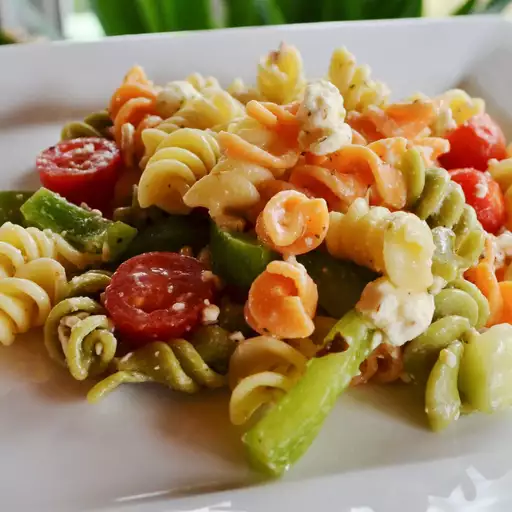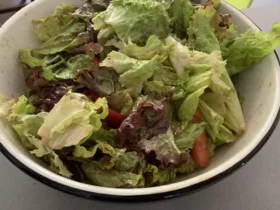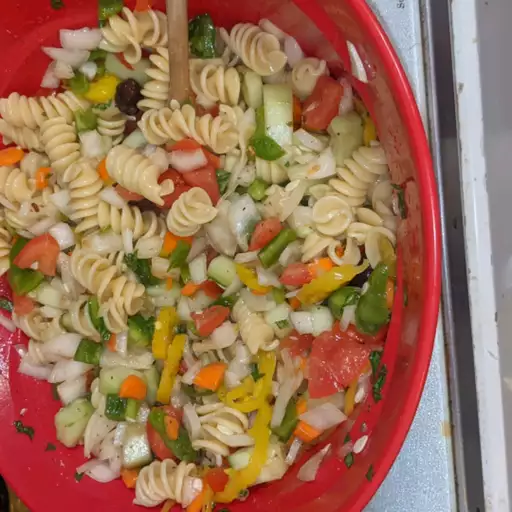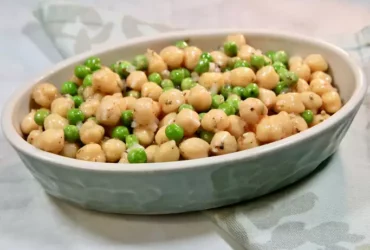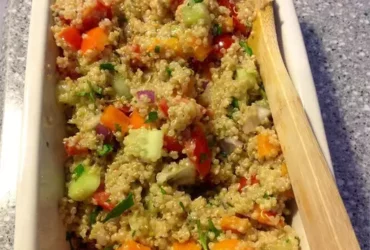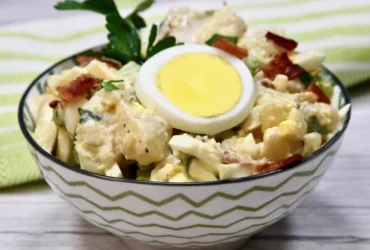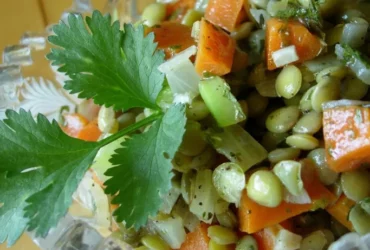Ingredients
Fresh Vegetables
The star ingredient of our Greek pasta salad recipe are fresh vegetables, which add natural sweetness, crunchiness, and flavor to the dish.
The key to a great pasta salad is to use high-quality ingredients, particularly when it comes to the fresh vegetables.
Fresh Vegetables Used in Our Greek Pasta Salad Recipe
- CucumberA refreshing and hydrating ingredient that pairs well with tomatoes and feta cheese. Look for English or hothouse cucumbers, which have a thicker skin and fewer seeds than traditional cucumbers.
- TomatoesWe use cherry or grape tomatoes, which are sweeter and burst with flavor when cooked. You can also use other types of tomatoes like Roma or beefsteak tomatoes for added texture.
- A sweet and slightly smoky ingredient that complements the flavors of feta cheese and olives. Green, red, or yellow bell peppers work well in this recipe.
- Kalamata OlivesA salty and savory ingredient that adds depth to the dish. You can use green or black olives instead, depending on your preference.
- Red OnionA sweet and tangy ingredient that pairs well with tomatoes and feta cheese. Look for red onions with a firm texture and no signs of sprouting or mold.
- Fresh ParsleyA bright and herbaceous ingredient that adds freshness to the dish. Use curly-leaf parsley or flat-leaf parsley, depending on your preference.
When selecting fresh vegetables for our Greek pasta salad recipe, make sure they are firm, brightly colored, and have no signs of spoilage or damage.
To prepare the fresh vegetables for the recipe, peel and slice the cucumber and red onion into thin strips. Cut the bell peppers into bite-sized pieces. Slice the tomatoes in half or quarters, depending on their size. Chop the fresh parsley leaves and stems into small pieces. Pit the olives and chop them into smaller pieces.
Now that we have our fresh vegetables prepared, let’s move on to cooking the pasta and assembling our Greek pasta salad recipe.
8 oz (225g) of bowtie pasta (farfalle), cooked al dente
The ingredients for our Great Greek Pasta Salad Recipe require a specific type and quantity of bowtie pasta, also known as farfalle. This Italian pasta shape is ideal for salads due to its distinctive bow-tie shape, which allows it to hold onto sauces and seasonings effectively.
To achieve the perfect texture for our salad, we need to cook the farfalle al dente, which means cooking it until it retains some firmness in the center. This can be done by following the package instructions for cooking time, but as a general guideline, 8 oz (225g) of bowtie pasta typically requires boiling for around 7-9 minutes.
It’s essential to not overcook the pasta, as this will make it mushy and unpleasant in texture. To check if the farfalle is cooked al dente, simply take a piece out of the water and bite into it. If it still has some resistance in the center but is no longer hard, then it is ready to use in our Greek Pasta Salad Recipe.
Once the pasta is cooked, drain it thoroughly in a colander under cold running water to stop the cooking process and remove excess starch. This will help prevent the pasta from sticking together and make it easier to toss with other ingredients and dressings later on.
We can now use our cooked al dente bowtie pasta as the base for our Great Greek Pasta Salad Recipe, combining it with a variety of flavorful ingredients such as juicy tomatoes, creamy feta cheese, crunchy cucumbers, and refreshing herbs like parsley and dill. The resulting salad will be a perfect blend of Italian pasta and classic Greek flavors, sure to delight your taste buds.
1 cup of cherry tomatoes, halved
Cherry tomatoes are a key ingredient in this Great Greek Pasta Salad Recipe, and it’s essential to choose the right type for optimal flavor and texture. For this recipe, you’ll want to use small to medium-sized cherry tomatoes that are sweet and have a low acidity level.
The reason for using halved cherry tomatoes is so that they’re bite-sized and evenly distributed throughout the salad. This also helps to prevent them from overpowering the other flavors in the dish.
When selecting your cherry tomatoes, look for ones that are firm and have a bright red color. Avoid any that are soft or discolored, as these may not hold up well in the salad.
To ensure that the halved cherry tomatoes stay fresh and vibrant throughout the recipe’s preparation, it’s best to halve them just before adding them to the pasta mixture.
1 cup of cucumber slices
To create this refreshing pasta salad, we’ll need to focus on the ingredients that will bring together the perfect harmony of flavors and textures. Starting with the vegetables, a key component is:
Cucumber Slices
We’ll require approximately 1 cup of cucumber slices for this recipe.
For the best results, choose a firm and crisp variety of cucumber. English or hothouse cucumbers work well for slicing and are readily available in most supermarkets. Simply peel the cucumber, slice it into 1/2-inch thick rounds, and set aside.
As you continue assembling the ingredients for your Great Greek Pasta Salad, remember to select high-quality components that will elevate the flavor and presentation of your dish. This includes pasta, vegetables, cheese, olives, and a zesty dressing.
1 cup of Kalamata olives, pitted
Kalamata olives are a type of black olive that originates from Greece, and they are a staple ingredient in many Greek dishes.
When using Kalamata olives in cooking, it’s essential to pit them first, which involves removing the seed or stone from the center of each olive.
Pitting Kalamata Olives
To pit Kalamata olives, you can use a combination of manual and mechanical methods:
- Using a small knife, carefully cut along the length of each olive to loosen the seed from the surrounding flesh.
- Gently pry out the seed using a toothpick or your fingers. Be careful not to tear the olive’s flesh.
For large quantities of olives, you can also use an olive pitter tool, which resembles a small screwdriver with a pointed tip at one end and a flat surface on the other. This tool allows you to easily remove the seeds from multiple olives at once.
Choosing Fresh Kalamata Olives
To ensure that your pasta salad has the best flavor, choose fresh and high-quality Kalamata olives:
- Select olives that are free of visible blemishes or signs of mold.
- Choose olives with a deep purple color, as they will have the most intense flavor.
Remember to store your pitted Kalamata olives in an airtight container and keep them refrigerated until you are ready to use them in your pasta salad recipe.
1 cup of red onion, thinly sliced
The star ingredient that adds a punch of flavor to this Greek pasta salad recipe is the red onion. Thinly slicing it allows its sweet and pungent flavors to meld with the other ingredients.
One cup of thinly sliced red onion may seem like a lot, but trust us, it’s perfect for this recipe. The sweetness of the onion will balance out the tanginess of the feta cheese and the acidity of the tomatoes.
The key to using red onion in this recipe is to slice it thinly. This will help it cook evenly and quickly, so it doesn’t overpower the other flavors. You can use a mandoline or a sharp knife to get thin, even slices.
When you’re ready to add the red onion to your salad, make sure it’s at room temperature. This will help it mix well with the other ingredients and prevent it from becoming soggy.
The best part about using red onion in this recipe is that it adds a depth of flavor that’s hard to replicate with other ingredients. It’s sweet, pungent, and savory all at once, making it a perfect addition to your Greek pasta salad.
Proteins and Cheese
The foundation of a delicious Great Greek Pasta Salad Recipe lies not just in its flavorful ingredients, but also in the combination of proteins and cheese that bring it to life. When it comes to choosing ingredients for this dish, there’s no one-size-fits-all approach; rather, you have the freedom to get creative with your selections.
Starting off, we need a solid base – pasta, which serves as both the structural element and the vessel for all the other flavors and textures. A good Greek salad is characterized by its use of pasta that’s dressed in a way that complements the rich and tangy dressing without overpowering it; so, you might consider opting for shapes like penne or bowtie (farfalle), which provide plenty of surface area for the sauce to cling onto.
Now let’s talk about proteins. These are what add substance and heft to a salad that could otherwise feel a bit light – think of them as the anchors that keep everything in place. Common protein sources in Greek salads include grilled chicken, salami or other cured meats like pepperoni or ham, and even occasionally, tuna (especially if you’re looking for a seafood option). For this particular recipe, let’s go with chicken as our go-to source of protein.
Chicken breast is a popular choice here because it offers a leaner alternative to red meat without sacrificing flavor. When cooking the chicken, we want to make sure it remains juicy and tender by not overcooking it – aim for an internal temperature of about 165°F (74°C), and let it rest before slicing it thinly.
But now that our proteins are taken care of, it’s time to talk about cheese. Cheese plays a significant role in the Great Greek Pasta Salad Recipe as both a flavor enhancer and textural element. Feta is often at the top of many people’s lists when considering which type of cheese to use; it adds a tangy salty kick that complements the herbal flavors in a typical Greek salad.
However, if you’re looking for something slightly different or want to cater to vegetarian diets, consider goat cheese (chevre) as an alternative – it has a softer texture than feta and carries a milder flavor. Regardless of which type of cheese you choose, make sure it’s crumbled into small pieces before mixing it with the other ingredients in the salad.
Once all these elements are combined, our Great Greek Pasta Salad Recipe is starting to take shape. At this point, we can start thinking about how we want to finish it off – perhaps by adding some chopped fresh herbs like parsley or dill to give it that extra burst of freshness and vitality? The beauty of this salad lies in its versatility, so don’t be afraid to get creative!
8 oz (225g) of grilled chicken breast, diced
To make a delicious Great Greek Pasta Salad Recipe, you’ll need to start with high-quality ingredients. One essential component is 8 oz (225g) of grilled chicken breast, diced.
Here’s what you can do with it:
- Dicing the ChickenSlice the grilled chicken into small, bite-sized pieces. This will make it easier to distribute throughout the salad and ensure that each bite has a good balance of flavors.
You want the diced chicken to be around 1/4 inch (6 mm) in size for optimal texture and distribution. This way, you can sprinkle it evenly over your pasta salad without making any single serving too large or overwhelming.
1/2 cup of crumbled feta cheese
Feta cheese is a staple ingredient in traditional Greek cuisine and plays a crucial role in adding a salty, tangy flavor to this Great Greek Pasta Salad recipe.
In order to prepare 1/2 cup of crumbled feta cheese, you will need to start with a block of high-quality feta cheese. Feta is typically made from sheep’s milk or a combination of sheep and goat’s milk, although some variations may also be made with cow’s milk.
The best type of feta cheese for this recipe would likely be a Greek-style feta that has been aged to perfection, developing a rich, creamy texture and a salty, slightly tangy flavor. Look for a block of feta that is dense and firm in the center, with a white or off-white color.
To crumble the feta cheese, you can use your fingers or a fork to break it down into small pieces. It’s best to aim for a mixture of large chunks and smaller crumbs, as this will help distribute the flavor and texture throughout the salad.
One thing to note is that feta cheese is quite strong, so be careful not to overdo it with the amount you add to the recipe. A general rule of thumb would be to use about 1/2 cup of crumbled feta for every 8 ounces of pasta in this salad.
The key is to find a balance between the salty flavor of the feta and the other ingredients in the salad, such as the tomatoes, cucumbers, bell peppers, olives, and red onion. By combining these flavors in just the right proportions, you can create a truly authentic Greek pasta salad that’s both delicious and visually appealing.
Tangy Dressing
Sauce Preparation
Tangy dressing is a crucial component of a great Greek pasta salad, and preparing it from scratch can elevate the entire dish.
The foundation of tangy dressing is its acidic component, which typically comes in the form of vinegar or lemon juice.
Choosing the Right Acidic Component
- Vinegar: White wine vinegar, red wine vinegar, or apple cider vinegar can all be used as a base for tangy dressing. White wine vinegar has a neutral flavor and is often preferred in Greek cuisine.
- Lemon juice: Freshly squeezed lemon juice adds a bright and citrusy note to the dressing. Be careful not to add too much, as it can quickly become overpowering.
Once you’ve chosen your acidic component, it’s time to consider the richness that will balance out its tartness. This is typically achieved through the addition of oil or mayonnaise.
Add a Rich Component
- Oil: Olive oil is a popular choice for its distinct flavor and health benefits. Use a high-quality, extra-virgin olive oil to get the most out of your dressing.
- Mayonnaise: Mayonnaise can add a creamy texture and neutralize some of the acidity. However, be careful not to overdo it, as it can make the dressing too heavy.
Now that you have your acidic and rich components in place, it’s time to consider adding flavor enhancers that will take your tangy dressing to the next level.
Add Flavor Enhancers
- Dried oregano: This classic Greek herb pairs perfectly with tomato and cucumber, making it a staple in many salads.
- Garlic powder: Add a pinch of garlic powder to give your dressing a savory and aromatic flavor.
Mix all the ingredients together in a bowl until they’re well combined, then adjust the seasoning as needed. Some people like their tangy dressing sweeter, so feel free to add a bit of sugar or honey if that’s your preference.
1/4 cup of olive oil
The star of our Great Greek Pasta Salad Recipe is undoubtedly the _Tangy Dressing_ that brings all the flavors together.
One of the essential ingredients in this dressing is olive oil. You’ll need to use 1/4 cup of it, which is a generous amount that will add depth and richness to your salad. Make sure you choose high-quality olive oil with a good balance of acidity and flavor.
Now, let’s talk about the ratio of ingredients in our Tangy Dressing. Here’s a breakdown:
- 1/4 cup _olive oil_
- 2 tablespoons red wine vinegar (for that tangy taste)
- 1 teaspoon Dijon mustard (to add a bit of spice and texture)
- 1 clove garlic, minced (for an extra kick)
- 1 teaspoon dried oregano (for a classic Greek flavor)
To make the dressing, simply whisk all these ingredients together in a bowl until they’re well combined. You can adjust the amount of olive oil to your taste, but keep in mind that you want it to coat all the pasta and vegetables evenly.
Once you’ve made your Tangy Dressing, you’ll be ready to assemble our Great Greek Pasta Salad Recipe. It’s time to add the cooked pasta, cherry tomatoes, cucumber, red onion, feta cheese, Kalamata olives, and artichoke hearts. Don’t forget to sprinkle some chopped fresh parsley on top for extra flavor and color!
With this delicious salad recipe, you’ll have a perfect combination of flavors and textures that will leave your taste buds dancing the Greek dances!
2 tbsp of freshly squeezed lemon juice
The star of our Great Greek Pasta Salad recipe is undoubtedly the tangy dressing, which perfectly balances the flavors and textures of the dish.
One of the key components of this dressing is freshly squeezed lemon juice, specifically 2 tablespoons of it.
Main Ingredients
Lemon JuiceFreshly squeezed from high-quality lemons, providing an intense and refreshing flavor.
This generous amount of lemon juice serves several purposes in the dressing:
- It adds a burst of citrus flavor, which complements the Mediterranean herbs and spices used in the recipe.
- It helps to balance the richness of the pasta and other ingredients by cutting through with its acidity.
Why Freshly Squeezed is Best
- FlavorFresh lemon juice has a more vibrant, dynamic flavor compared to bottled or processed alternatives.
- NutrientsFresh lemons are packed with vitamins and minerals, particularly vitamin C, which is lost during the processing of commercial lemon juice products.
When using freshly squeezed lemon juice in our Great Greek Pasta Salad recipe, be sure to:
- Squeeze the juice just before mixing it with the other ingredients to ensure optimal flavor and nutritional benefits.
1 tsp of Dijon mustard
Tangy Dressing is a crucial component of a delicious Greek pasta salad, and it’s surprisingly easy to make. The key ingredient that gives this dressing its distinctive tanginess is Dijon mustard.
Here are the ingredients you’ll need for this recipe:
- Dressing ingredients:
- 1/2 cup extra-virgin olive oil
- 1/4 cup white wine vinegar or red wine vinegar
- 1 tsp Dijon mustard (this is the key ingredient for tanginess)
- 1 tsp dried oregano
- 1 tsp lemon zest (optional, but highly recommended)
- 2 cloves garlic, minced
- Salt and pepper to taste
Now, let’s talk about the role of Dijon mustard in this recipe. You’ll need just 1 teaspoon of it to give your dressing that perfect balance of tanginess and creaminess.
Dijon mustard is a type of mustard made from white mustard seeds, which are less spicy than brown or black mustard seeds. It has a mild, slightly sweet flavor that pairs perfectly with the other ingredients in this recipe.
To make the dressing, simply combine all the ingredients (except the olive oil) in a bowl and whisk until smooth. Then, slowly pour in the olive oil while continuously whisking until the dressing is emulsified and creamy.
Here are some additional tips to help you create the perfect Greek pasta salad:
- Use high-quality ingredients: Fresh vegetables, good-quality cheese, and authentic Mediterranean spices will make a big difference in the flavor of your salad.
- Dress it just before serving: This will ensure that the flavors are at their best and that the dressing doesn’t become too soggy or oily.
- Let it sit for a while: Allow the salad to sit at room temperature for about 30 minutes to allow all the flavors to meld together.
This tangy dressing is perfect for Greek pasta salads, but you can also use it as a marinade or a sauce for grilled meats or vegetables. Experiment with different ingredients and flavor combinations to make it your own!
1 tsp of dried oregano
Tangy dressing is a key component in adding flavor to many dishes, including our featured recipe, _A Great Greek Pasta Salad_.
When it comes to creating a delicious and authentic Greek pasta salad, the choice of dressing is crucial. A good tangy dressing, such as Greek vinaigrette or a combination of red wine vinegar and olive oil, will help bring out the flavors of the vegetables and herbs used in the recipe.
In our Great Greek Pasta Salad Recipe, we call for 1 tsp of dried _oregano_ to be added to the tangy dressing mixture. Oregano is a popular herb in Greek cuisine, and its earthy, slightly bitter flavor pairs perfectly with the sweetness of tomatoes and cucumbers.
The combination of the tangy dressing and oregano adds depth and complexity to the salad, making it a truly authentic representation of traditional Greek flavors. By incorporating these elements into your pasta salad recipe, you’ll be able to transport yourself to the Mediterranean coast without ever leaving your kitchen.
Salt and pepper to taste
When it comes to creating a delicious and tangy pasta salad, using the right dressing can make all the difference. One popular choice for a Great Greek Pasta Salad Recipe is Tangy Dressing, which provides a perfect balance of flavors.
Tangy Dressing typically consists of a combination of ingredients such as red wine vinegar, olive oil, and spices like garlic powder and dried oregano. These components work together to create a savory and slightly sweet flavor profile that complements the pasta, vegetables, and feta cheese in your salad.
To make the most of your Tangy Dressing, it’s essential to use high-quality ingredients. Look for a good quality red wine vinegar with minimal additives, as well as a fragrant and fresh olive oil that will add depth to the dressing.
The key to creating a great Greek Pasta Salad is finding the right balance between tangy, sweet, and savory flavors. This is where Tangy Dressing shines, adding just the right amount of zest to your dish without overpowering it.
When using Tangy Dressing in your Great Greek Pasta Salad Recipe, be sure to mix well and adjust seasoning as needed with salt and pepper to taste. This will ensure that each bite is perfectly balanced and delicious.
Assembly and Tips
Tasting Notes
The art of Assembly is a crucial step in creating a stunning and delicious Greek Pasta Salad. It involves carefully combining all the ingredients, taking into account texture, color, and presentation.
To begin, start by preparing your ingredients. This includes cooking al dente pasta, chopping fresh vegetables, crumbled feta cheese, and thinly slicing red onions. Ensure that each ingredient is prepared to a high standard, as this will directly impact the overall quality of your salad.
When assembling your salad, consider the concept of layering. Start by adding a base layer of pasta, followed by the vegetables, feta cheese, and finally a sprinkle of chopped fresh parsley or dill. This not only adds visual appeal but also allows each component to shine.
The key to a great Greek Pasta Salad lies in its balance of flavors. The sweetness of the tomatoes, the tanginess of the feta cheese, and the crunch of the fresh vegetables all come together to create a harmonious taste experience. To achieve this balance, experiment with different combinations of ingredients and seasonings.
Tasting notes for a classic Greek Pasta Salad typically include:
- Freshness: The crunch and freshness of the vegetables, such as cucumber and bell peppers, should be evident in every bite.
- Sourness: The tangy flavor of feta cheese adds a delightful contrast to the sweetness of the tomatoes.
- Creaminess: A drizzle of tzatziki sauce or Greek yogurt can add a rich and creamy element to your salad.
- Spice: A sprinkle of red pepper flakes or dried oregano can add a subtle kick of heat and flavor.
Remember, the beauty of Greek Pasta Salad lies in its customization. Feel free to experiment with different ingredients, seasonings, and dressings to create your own unique recipe.
For a more intense flavor, use 1/2 cup of chopped red bell pepper in place of the cucumber.
Incorporating assembly and tips into a recipe like this Great Greek Pasta Salad is crucial for achieving the perfect blend of flavors, textures, and presentation. When it comes to assembling a pasta salad, timing is everything. It’s essential to prepare each component just before serving to prevent sogginess and to ensure that all the flavors meld together harmoniously.
Firstly, consider using high-quality ingredients such as whole wheat pasta or even quinoa for added nutrition. Cooking the pasta al dente is also vital, as it will help maintain its texture throughout the salad. When preparing the vegetables, thinly slice the red onion and cucumber to allow them to marinate evenly in the dressing.
Now, about that tip of substituting the cucumber with chopped red bell pepper for an intense flavor: this adds a sweet and crunchy element that complements the tanginess of feta cheese. This variation is perfect for those who prefer a bolder taste or want to add a pop of color to their salad.
Another crucial aspect of assembling a Greek pasta salad is balancing the flavors. Combine Kalamata olives with artichoke hearts and sun-dried tomatoes to create a savory mix that pairs well with the feta cheese. Don’t overdo it – a little goes a long way in preventing an overpowering taste.
As for tips, here are some additional suggestions: add a handful of chopped fresh parsley or dill for an herbaceous note; try using different types of pasta, such as orzo or penne, to change the texture and presentation; and consider adding a drizzle of lemon juice or zest to brighten up the flavors.
Ultimately, assembling this Great Greek Pasta Salad is all about experimenting with ingredients and flavors until you find your perfect combination. Don’t be afraid to get creative and make it your own!
To add some crunch, toss in some toasted almonds or walnuts.
When it comes to assembling a delicious Greek pasta salad, there are several tips and tricks that can take your dish from bland to grand.
Here are some essential tips to keep in mind:
- Choose the right pasta: A long, thin shape like penne or bowtie works well for this recipe. You want a pasta that will hold onto the flavors and ingredients without getting too mushy.
- Select high-quality ingredients: Fresh vegetables, herbs, and cheese can make all the difference in the taste and texture of your salad.
- Don’t overcook the pasta: You want it to still have a bit of bite to it. Al dente is perfect for this recipe.
- Toss with care: When combining the ingredients, use a large spoon or tongs to gently toss everything together. This will help prevent any one ingredient from getting smashed or broken.
Here are some additional tips to add extra texture and flavor:
- Add some crunch: Toss in some toasted almonds or walnuts for a satisfying crunch that complements the pasta and vegetables.
- Incorporate fresh herbs: Chopped parsley, dill, or oregano can add a bright, refreshing flavor to your salad.
- Get creative with cheese: Feta is traditional in Greek cuisine, but you could also try using crumbled goat cheese or ricotta for added creaminess.
Remember, the key to a great Greek pasta salad is balance. You want a combination of salty, sweet, tangy, and crunchy elements that all work together in harmony. Experiment with different ingredients and flavor combinations until you find one that suits your taste buds.
This recipe makes about 6 servings. Store leftovers in an airtight container for up to 3 days.
Pasta salads are a staple of Greek cuisine, and this recipe for a classic Greek pasta salad is a crowd-pleaser. To assemble and serve this delicious dish, follow these tips:
Assembly Tips
- Start by cooking the pasta according to the package instructions until it’s al dente. Drain and set aside to cool.
- While the pasta is cooling, chop the cucumbers, bell peppers, onion, and tomatoes into bite-sized pieces.
- In a large bowl, combine the cooled pasta, chopped vegetables, crumbled feta cheese, and chopped fresh parsley.
- Drizzle the Greek vinaigrette over the salad and toss to coat. Make sure all the ingredients are well coated with the dressing.
Tips for a Great Greek Pasta Salad
- Use high-quality feta cheese that’s crumbly and salty. This will give your salad a rich, authentic flavor.
- Don’t skip the red onion – it adds a pungent flavor and crunchy texture to the salad.
- Add some chopped Kalamata olives for a salty, savory element that complements the feta cheese.
- Make sure to use fresh parsley for the best flavor and aroma. You can also use dried parsley if fresh is not available.
This recipe makes about 6 servings. Store leftovers in an airtight container for up to 3 days. The salad will retain its flavor and texture even after it’s been refrigerated for a few hours or overnight.
- Best LeadsGorilla Alternatives for 2025 - April 22, 2025
- Best Leadzai Alternatives for 2025 - April 22, 2025
- Best LeadSwift Alternatives for 2025 - April 21, 2025

